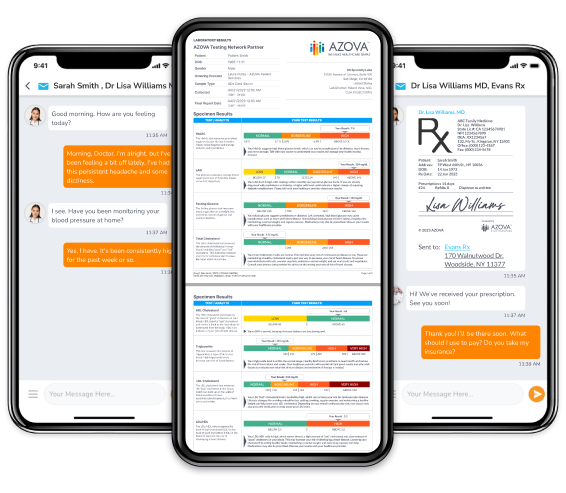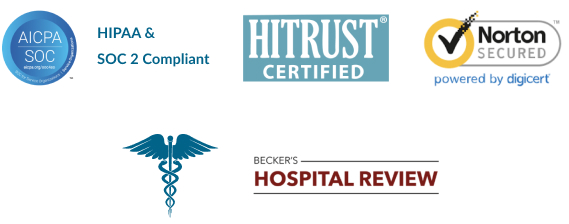Reliable rash treatment, just a click away.
Connect with a board-certified healthcare provider for rash relief via a quick, secured video visit or messaging. Receive a diagnosis and treatment plan, all without leaving home.
Available in all 50 states.

Understanding rashes
A rash is an abnormal skin condition characterized by redness, itching, or bumps.1-3 While many rashes are harmless, some can signal a more serious underlying health issue. Rashes can vary widely in appearance and cause.
Common rash types1, 6
- Contact dermatitis: An allergic reaction to a substance causing redness, itching, and blisters.
- Eczema: Characterized by dryness, itchiness, and inflammation of skin.
- Hives (urticaria): Raised, itchy welts that often appear suddenly.
- Psoriasis: A chronic autoimmune condition causing scaly, red patches.
- Ringworm: A fungal infection resulting in a red, ring-shaped rash.
- Rosacea: A chronic skin condition characterized by facial redness, visible blood vessels, and sometimes small, pus-filled bumps.
- Scabies: A skin infestation caused by mites, leading to intense itching and a bumpy rash.
- Rash symptoms in adults and children
- Rash causes in adults
- Rash causes in children
- Rash treatments for adults and children
Rash symptoms in adults and children1-2
Redness
Redness is a common sign of a rash. It can range from mild pinkness to intense red patches. Often accompanied by itching or warmth, redness may indicate inflammation or irritation.
Itching
An uncomfortable sensation that often accompanies rashes. Itching can range from mild discomfort to severe irritation, and scratching can worsen the rash.
Bumps
Raised areas on the skin that may be filled with fluid (blister) or solid. They can vary in size, shape, and color, and are often a symptom of an underlying skin condition.
Scaling
Dry, flaky patches on the skin’s surface. Scaling is commonly associated with eczema and psoriasis, but can occur with other skin conditions.
Pain
A symptom indicating a more serious skin issue. Rash-related pain may be accompanied by swelling, redness, or warmth, and often requires medical attention.
Rash causes in adults
Rashes can affect adults, with various causes ranging from allergies to infections. Prompt and accurate identification is crucial for effective treatment and preventing complications.1-3
Infections
Bacterial, viral, or fungal infections can cause skin outbreaks. Common examples include impetigo, shingles, and ringworm.
Allergies and irritants
Exposure to substances like pollen, pet dander, certain foods, chemicals, or plants can trigger skin reactions ranging from mild irritation to severe allergic responses.
Insect bites
Bug bites typically cause itchy, red bumps. However, in some cases, severe allergic reactions, such as anaphylaxis, can occur, requiring immediate medical attention.
Autoimmune diseases
Conditions where the immune system attacks healthy cells can cause various skin rashes. Examples include lupus and psoriasis.
Medications
Certain drugs may trigger allergic reactions or skin irritations. Always consult with a healthcare provider if you suspect a medication allergy.
Environmental factors
Exposure to extreme temperatures, sunlight, or other environmental triggers can contribute to rash development. Proper sun protection and avoiding irritants can help prevent these rashes.
Rash causes in children
Rashes can affect children, with various causes ranging from allergies to infections. Prompt and accurate identification is crucial for effective treatment and preventing complications.5
Dermatitis
A general term for skin inflammation, dermatitis encompasses various conditions like eczema, diaper rash, cradle cap, and contact dermatitis. It often causes redness, itching, and dryness.
Viral infections
Viral infections can cause a variety of symptoms in children, including fever, fatigue, and a characteristic rash. Common viral culprits include chickenpox, measles, rubella, and fifth disease, among others.
Bacterial infections
Conditions like impetigo and scarlet fever are commonly caused by bacterial strains. These infections often require antibiotic treatment.
Fungal infections
Common examples include ringworm, which is characterized by itchy, red, circular rashes. Antifungal medications are typically used for treatment.
Teething
Skin irritation caused by excessive drooling during teething often appears as red bumps on the face, neck, and chest. While generally harmless, it can cause discomfort.
Rash treatments for adults and children2-3
Home remedies
Soothe discomfort with cool compresses, unscented moisturizers, and over-the-counter antihistamines or non-steroidal anti-inflammatory anti-itch creams. Avoid scratching and irritants for faster healing.
Topical medications
Prescription creams and ointments target specific rash types. Calamine lotion or hydrocortisone (used cautiously) may provide temporary relief.
Oral medications
For severe or persistent rashes, oral medications like antibiotics, antifungals, or corticosteroids may be necessary to address the underlying cause.
AZOVA Virtual Urgent Care
- Mild rashes: If you or your child have a mild rash and are otherwise healthy, Virtual Urgent Care can be a convenient option for consultation and initial treatment.
- Persistent rashes: If the rash does not improve with home remedies or worsens over time, seek Virtual Urgent Care for further evaluation and treatment.
- Severe rashes: If you or your child are experiencing severe symptoms, such as intense itching, widespread redness, or blisters, it’s important to seek immediate in-person medical attention.
Don’t suffer through itchy, irritated skin. Get treatment for rashes today.
References
1Patient First. (n.d.). Treatment for Minor Illnesses. Retrieved from https://www.patientfirst.com/services/illnesses/rashes
2Kopp, S. D. (2022, July 28). Rashes and Virtual Urgent Care. Mass General Brigham. Retrieved from https://www.massgeneralbrigham.org/en/about/newsroom/articles/virtual-urgent-care-rashes-and-blisters
3American Academy of Dermatology. (n.d.). Rash 101 in adults: When to seek medical treatment. Retrieved from https://www.aad.org/public/everyday-care/itchy-skin/rash/rash-101
4Haleem, A., Javaid, M., Singh, R. P., & Sumanc, R. (2021, July 24). Telemedicine for healthcare: Capabilities, features, barriers, and applications. [National Institutes of Health] National Center for Biotechnology Information. Retrieved from https://doi.org/10.1016/j.sintl.2021.100117
5American Academy of Dermatology. (n.d.). Telemedicine: How to prepare for your appointment. Retrieved from https://www.aad.org/public/fad/digital-health/telemedicine/prepare-appointment
Need help or have questions?
Contact our AZOVA Customer Support team below
Live 24/7 chat
(quickest response)
You can chat with AZOVA’s Customer Support team for comprehensive support, including help with your account, testing, shipping, and results.
We typically respond within 5 minutes. Click the messaging icon on the lower right corner of the page to get started.



